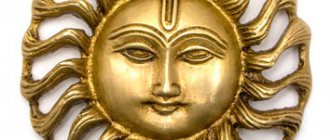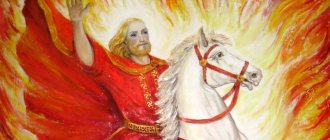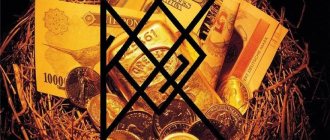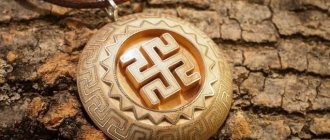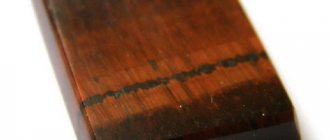The sun is the source of life on our planet, therefore, since ancient times, it has been primarily a symbol of creative energy. For many peoples, solar deities were the strongest and most powerful. They were depicted either as anthropomorphic creatures with a halo above their heads or a disk instead, or as a solar circle with a human face. Also, the oldest solar symbols are the cross and the wheel.
Hungarian postage stamp depicting one of the Seven Wonders of the World - the Colossus of Rhodes, a huge statue of the solar god Helios
Fleeing from the Cretan king Minos, Daedalus and his son Icarus made wings for themselves and flew away from the island. However, during the flight, Icarus flew too close to the Sun, scorched his wings, fell to the ground and crashed
Since solar heat can not only give life, but also kill, solar symbolism has both positive and negative features. In some cultures, the Sun acts not only as the basis of life, but also as a killer. The motifs of the black, dead Sun were embodied in the mythological images of Osiris and Hades. The annual solar cycle formed the basis of many calendars and almost all important holidays of agricultural peoples. Most cultures around the world celebrate 4 main phases of the Sun: winter solstice, spring equinox, summer solstice and autumn equinox. Since these phases are turning points for seasonal cycles, this determined their enormous influence on agriculture and, accordingly, calendars.
In the Roman Empire, the god Mithras was revered as a symbol of the invincible Sun. After the adoption of Christianity, this image spread to Christ, who also began to be revered as a solar deity.
Allegorical image of the Sun. Based on an engraving from G. Bruno’s treatise “On Images, Signs and Symbols”
Major Arcana “Sun” from the Tarot deck of the Duke of Visconti, 15th century.
Back at the end of the 3rd century. In Rome, the celebration of the birthday of the Sun was introduced, falling on December 25, and only at the end of the 4th century, after the official adoption of Christianity, the church decided to celebrate the Nativity of Christ on this day.
Some researchers believe that the image of the triune deity, which developed into the Christian Holy Trinity, is rooted in solar symbolism and embodies the sunrise, zenith and sunset. At the same time, these three solar phases symbolize growth, maturity and decline.
The Triple Spiral is an ancient Celtic solar symbol.
The swastika is an ancient solar symbol of the Indo-Europeans
The ancient Slavs worshiped three solar deities: Khors, Dazhd-God and Svarog. Later, the Sun was represented as a wheel from the chariot of Elijah the prophet, in which he rides across the sky. It was believed that during the day the Sun monitors the affairs of people, and in the evening reports them to God. Our ancestors used solar symbolism as a powerful amulet, decorating their clothes and household items with swastikas, crosses, circles and rosettes.
In Western astrology, the Sun rules active life energy. Solariums are people who have an attractive appearance and developed intelligence. They are able to charge those around them with their energy, but they themselves do not succumb to the influence of others.
Odin's knot - the solar symbol of the ancient Germans
Emblem of the Jesuit Order
The meaning of the sun for humanity
Almost all the tribes that have ever existed on our planet worshiped the celestial body. He was considered an eternal and powerful force, a source of inexhaustible energy. People have always associated grace and their hopes for a better future with the sun.
Thanks to observations of the burning star, humanity has made many discoveries. This is a wheel, a calendar and other amazing things. Therefore, it is not surprising that even modern people very often use the symbol of the sun in amulets and tattoos.
Historical aspects of the origin of amulets with sun symbols
All solar amulets that have ever existed were dedicated to a specific deity associated with the sun. As mentioned above, the deification of the sun did not exist among scattered tribes, but appeared only with a single ruler.
Before this, the luminary was perceived as an inanimate object with which certain events occur (appearance, disappearance, return, etc.).
There were also ideas about the sun and the moon as certain anthropomorphic characters (often twins) of different sexes who enter into a marriage union (the theme of incest is generally characteristic of the mythology of the vast majority of peoples).
Moreover, the sun in archaic myths is often perceived as a male character, and the moon, accordingly, as a female one.
The deification of the sun (and at the same time its representation as a male character) arises with the advent of kings. Among the first to be described is the solar god Shamash among the Babylonian and Assyrian peoples, who gradually comes to the fore among other deities.
The solar cult received much greater development among the ancient Egyptians, who initially had several solar gods at once:
- Ra is the supreme god, the sun god, depicted with the head of a falcon and the body of a man;
- Horus - the god of the sky, the sun and the patron of the pharaohs, was depicted almost similarly to Ra, and is a descendant of the latter;
- Amon is the god of the air, and subsequently the sun (like Amon-Ra)
- Khepri is the god of rebirth, the dawn, and the divine scarab beetle that rolls the sun along its celestial path, resulting in sunset and sunrise.
One of the Egyptian pharaohs, Akhenaten, in the 14th century. BC e. tried to bring such a multiple cult to just one deity - Aten (who was originally just an abstract designation for the sun).
Before this reform, Akhenaten bore the name Amenhotep IV, and took such a pseudonym to emphasize his connection with the one god.
As a result, during his reign, the sun, and at the same time the pharaoh, began to be identified with the supreme deity (but the following rulers returned polytheism back).
You may be interested in: Amulets and symbolism of the ancient Slavs: meaning and interpretation
The cult of the sun became widespread among a number of Indo-European peoples: Armenians, Baltic peoples, Indians, Iranians, Scandinavians, Greeks, Romans, Slavs and others:
- Among the ancient Armenians, the sun god was named Arev and was the personification of the luminary. Sometimes depicted as a wheel;
- Among the Baltic people, Saule is the mother goddess, the solar goddess. Unlike the supreme god Dievas, he is directly involved in the destinies of people (helping those in need and punishing sinners). Periodically enters into a struggle with Dievas, which ends with the summer solstice. According to legends, Saule rides across the sky in a chariot drawn by fiery horses;
- Surya is the Indian sun god (many researchers consider him functionally related to the Baltic Saula). By the way, he is also endowed with an attribute in the form of a chariot, which is drawn by 7 horses, personifying the rays of the sun;
- Frey is the solar god of the Scandinavians. He sends harvests and peace between people to the earth, and his sacred animal is the boar;
- The Greeks had two solar deities - Helios and Apollo. Over time, both names became associated with the same deity. Selene, the goddess of the moon, was considered the sister of Helios;
- among the Romans, Sol was a deity similar to Helios and Apollo. By the way, at first he was equated with the two-faced Janus, but later stood out as a separate character;
- Among the ancient Iranians (Zoroastrians), Mithras was the sun god, and he also patronized harmony and contracts. Subsequently, a whole cult dedicated to him arose - Mithraism;
- Among the Slavs, Horse was considered the personification of the sun, but its manifestations were quite diverse, which will be discussed below.
Solar cults were also of great importance in the mythologies of the peoples of South and Central America (Huitzilopochtli among the Aztecs, Inti among the Incas), the Japanese (the sun goddess Amaterasu) and many others.
BY THE WAY! Modern researchers are of the opinion that ethnographers of the 18th and 19th centuries attached excessive importance to solar cults, associating a number of mythological characters with the sun, when in fact they were not connected at all. However, it is currently not possible to verify the truth of this or that point of view.
Solar gods of the Slavs
Slavic solar deities are usually divided according to “calendar” (“seasonal”) criteria:
- According to some sources, Khors himself was considered the personification of the winter sun, and according to others, Kolyada (a number of researchers, however, consider him a folklore character not related to deities at all). The corresponding amulets are the Khorsa sign (4-rayed swastika) and the carol amulet (8-rayed swastika);
- Yarilo is the personification of the luminary in the spring (according to ethnographers, this is also not a deity, but a personification of a separate holiday and spring). It was believed that his time began on March 21. In addition to the sun, it personifies carnal love and fertility. It corresponds to the Slavic amulet Yarilo - an image of the sun enclosed in a circle, as well as the spring charm - a rounded 4-ray swastika;
- Dazhdbog (one of the supreme Slavic deities and the sun god), as well as Kupala (like Yarilo, a folklore character personifying a certain holiday) were associated with the summer sun. The amulets associated with them are the sign of Dazhdbog (the so-called “straight cross”, consisting of 4 symmetrical rhombuses, 2 of which are closed, and 2 are not) and the Kupalo amulet (a rhombus, inside which 2 intersecting curves form another rhombus );
- in the autumn period (starting from the day of the autumn equinox), Avsen (or Sventovit) and Svarog were considered the personification of the sun. The corresponding amulet is Svetovit - a multi-directional double 8-ray swastika, the Tausen amulet - a peculiar combination of straight and oblique crosses, as well as all kinds of amulets attributed to Svarog: hammer, cross, Russian star (square), wheel.
ATTENTION! It is believed that a suitable amulet can be chosen precisely according to the “calendar sign” - by date of birth (see the table “Slavic solar amulets”).
The sign of the sun in ancient times
Archaeologists have repeatedly found rock paintings of the sun. In ancient times, people depicted the celestial body as a closed circle with a small dot in the center. This very first form symbolized self-knowledge and the cyclical nature of things happening in the world. Sun signs were also applied to amulets, jewelry, items of clothing, and houses were decorated with them. People considered the burning star to be a kind of deity, worshiped it and were even afraid of it.
The general meaning of the solar pattern is the natural flow of time, which is characteristic of the entire universe. The closed rim of the circle testifies to the infinity of everything that exists on earth. People put such a sacred meaning into the symbol of the sun in Egypt, Asia, India and other ancient civilizations.
Over time, each nation developed its own sign of the heavenly body, which had a special meaning.
What is a talisman
Almost all the peoples living on our land worshiped the Sun. He was considered the most powerful force that could protect and bring good luck. In magic, the luminary was used as a symbol of inexhaustible power. The sun amulet in one form or another was found in almost every nation. In Egypt, the sun talisman was considered a symbol of purification and the desire for the divine.
Masons considered it a symbol of the soul thirsting for perfection. In Slavic culture, the amulet personified the four elements. It was considered the most necessary for warriors, as well as forest guardians. The ancient Aztecs used the sunstone as a calendar. It was used to find out when there would be a solar or lunar eclipse or a planetary revolution. Therefore, it is often worn by those who strive to learn how to use their time rationally.
The Scandinavian peoples used the talisman to obtain a good harvest, prosperity, and an abundance of fruits in gardens and fields. Not everyone was allowed to wear an amulet with the image of a black sun. Usually this is a symbol of the ancient wise men, who had access to the secrets and wisdom of the universe.
Solar symbol among the peoples of the world
For the Aztecs, the closed circle served as a kind of multifunctional calendar, which had the appearance of a sun stone. With its help, they determined astrological data and found out the time. The talisman was also used for harmonization and knowledge of the future.
The Indians believed in the solar spirit, which is the progenitor of everything and is responsible for the cycle of things. Amulets with his image gave strength and protection to warriors, warmed them on cold nights and brought good luck.
The Scandinavians described the symbol as a wheel from the quadriga of the sun itself. It was made exclusively from gold. And it meant only positive things: prosperity, prosperity, health, fertility and a rich harvest.
The symbol of the sun in ancient Egypt bore the original name - “winged disk”. He personified Horus, who stood up to fight Set. The talisman was used to protect against any negativity, be it witchcraft or physical influence.
The Slavs loved to make nauzes - amulets in the form of knots, personifying the sun. They performed protective functions and drove away dark thoughts. People actively make such amulets to this day.
Let's look at the Slavic symbols of the sun in more detail.
To gain knowledge
Svarga is a talisman that is very different from any other amulets of the ancient Slavs.
It was not used in everyday life or in war; only the priests knew about it - and they used it extremely rarely. This symbol contains knowledge about the multidimensionality of our reality, about its complex and completely unobvious structure. Only those people who gave their lives to comprehend great and true wisdom could realize the full power of this symbol. This symbol looks like a swastika with an eight-pointed cross hidden inside it. It must be said that even today this talisman is rarely used by anyone.
As you can see, our culture is rich in symbols and amulets, each of which has its own sacred meaning. The sun and moon formed the basis of the life and worldview of the ancient Slavs, influenced their way of life and were the most important images in their worldview. Author: Daria Potykan
Yarilo
This god was depicted as the sun or a bearded old man. A similar sign was applied to restore energy, balance, protection from any influences, gaining wealth, happiness, good offspring, maintaining health and masculinity.
The Slavic symbol of the sun greatly helped in family matters and was considered a home talisman. It was often placed as an amulet or figurine in the hallway, bedroom, living room and kitchen. Also, some craftsmen carved the image of Yarila on the external walls of houses.
What do the rays symbolize?
Astrologers were not long ago able to explain what the rays in amulets mean. On the star chart, you need to carefully consider the location of Ursa Minor and Ursa Major at midnight during the summer and winter solstices, as well as the autumn and spring equinoxes. If you draw imaginary lines from the North Star to these constellations, then you will get the sun's rays. It can be assumed that our ancestors used this sign to determine location.
In amulets, the rays are enclosed in a circle, thereby symbolizing the continuous cyclical nature of existence. They can also be bent clockwise and in the opposite direction. Among the Slavs, the symbol of the sun can have very different meanings depending on the number of rays depicted. Four means fire that burns on the earth. Six rays symbolize the wheel of the god Perun. And eight represents the power of solar fire.
Solar cross
This symbol has four rays and personifies natural elements, as well as important events in life: the autumn and spring equinoxes, the summer and winter solstices. This amulet was most suitable for forest guardians and warriors.
This sign was worn as an amulet only by mature people in order to receive the help of their ancestors in gaining wisdom and raising a child. The symbol of the sun in the form of a cross was not allowed to be worn by children, boys and girls, since it was believed that it would spoil the character or disrupt the psyche.
Who is the sun amulet suitable for?
An amulet with a solar symbol suits almost everyone. It helps to protect oneself from outside negative influences, gain and maintain peace of mind and tranquility, and also attracts good luck into the life of the wearer.
You may be interested in: How to make a broom amulet and how to hang it
There are several categories of people who are especially recommended to wear such a talisman:
- born under “fire” zodiac signs (these include Leo, Sagittarius and Aries). It is believed that the talisman is especially suitable for Leos, since they are protected by the Sun. In addition, people born in the corresponding periods are determined and assertive, but their energy reserves are quickly depleted. A solar amulet will help them replenish their strength;
- children. A solar talisman will help a child get sick less, recover faster after an illness, and also develop existing potential more effectively (however, as will be discussed below, children are not recommended to wear this amulet constantly, but only during periods of illness, recovery, or important events);
- adults born under any zodiac sign, during a period of exhaustion and energy decline.
ATTENTION! The overall effect of a talisman with the sun is to suppress aggression, maintain inner harmony and calm. At the same time, the amulet also adds determination to the wearer and helps to find the right decisions.
Solstice
It is considered a very powerful sign, since it combines three gods at once - Dazhdbog, Yaril and Khors. It has six beams that can be directed either clockwise or counterclockwise. The first option refers to the summer solstice, and the second – to the winter solstice. These symbols are also called Thunderer and Thunderer.
The solstice is considered a masculine symbol because it gives strength for battles. If a woman has a fighting character, then such a talisman will not harm her. But usually girls wore other amulets - lunars. The six-ray symbol of the sun among the Slavs performed a protective function and brought victory. Therefore, he was depicted everywhere: on gates, entrance doors, weapons, military banners and clothing.
Kolovrat
Kolovrat is the most popular among Slavic symbols. It has eight rays directed clockwise and closed in a circle. This sign best reflects the celestial body.
The interesting name of this symbol is easily explained. "Kolo" means wheel, circle. And the “gate” particle is movement. It turns out that the Kolovrat sign symbolizes the rotation of the circle, the continuity of existence and eternal life. Therefore, people believed that this solar sign brings only good things: a rich harvest, protection from evil, health and good luck in good deeds. The Slavic symbol of the sun - Kolovrat - was depicted as a pattern on kitchen utensils, embroidery and household items. And today it is popular as an amulet, made of various alloys or wood.
Kolovrat is a symbol of the sun
In Rus', a cross with curves had a Russian name - “Kolovrat”; its meaning is interpreted as “Sun” and “rotation”, or “solstice”. Images of Kolovrat in the form of ornaments covered the altars of ancient Russian churches, chasubles, iconostases, military banners, embossed weapons, lapels of national costumes, lace, house frames, utensils, etc. This is evidenced by fragments of paintings in Kyiv, Chernigov, Novgorod, Vologda.
Neither Europe, nor India, nor Asia can compare with Russia or Siberia in the abundance of solar symbols covering Russian weapons, banners, national costumes, household utensils, everyday and agricultural items, as well as houses and temples. Excavations of ancient mounds, cities and settlements speak for themselves - many ancient Slavic cities had a clear shape of a Kolovrat, oriented to the four cardinal directions.
For example, the dome of the ancient Kolomna Church of the beheading of John the Baptist is decorated with a mosaic figure of the rotating Sun with spirally curved rays diverging from it and points of the planets along the periphery of the sky. The ancient painting of the portico of the Kyiv St. Sophia Cathedral, made under Yaroslav the Wise in the form of a series of left-handed lines, also captivates the imagination. - and dextrorotatory swastika-kolovrat and straight crosses.
She personifies the Yarilo-Sun, Light, the change of seasons, and is a great cleansing and protective force, which is why the dark forces of evil hate her so much. It is no coincidence that Kolovrat was inscribed on the red shields of Slavic warriors going into mortal combat, often against superior enemy forces. This determination of the Kolovrat caused panic among the enemies, ultimately bringing victory to the Slavs. This is how our great Ancestors, for thousands of years, held back all the devastating invasions: Greeks, Romans, Huns, Goths, Obra, Khazars, Polovtsians, Pechenegs, Byzantines, Varangians.
Based on the fact that the Kolovrat is a rotating cross with curved ends directed clockwise or counterclockwise, now all over the world all such symbols are called in one word - swastika, which is incorrect. After all, each swastika symbol in ancient times had its own name, purpose, Protective Power and Figurative meaning, and not at all the ideas that were put forward by Adolf Hitler.
An amazing fact, but now few people know that the matrices of the 250 ruble banknote, with the image of the swastika symbol - Kolovrat - against the backdrop of a double-headed eagle, were made according to a special order and sketches of the last Russian Tsar Nicholas II. The Provisional Government used these matrices to issue banknotes in denominations of 250, and later 1000 rubles. Beginning in 1918, the Bolsheviks introduced new banknotes in denominations of 5,000 and 10,000 rubles, which depicted three Swastika-Kolovrat: two smaller Kolovrat in side ligatures intertwined with large numbers 5,000, 10,000, and a large Kolovrat is placed in the middle.
Slavic symbols and swastika
Slavic symbols are often considered primordially fascist signs. But this is fundamentally wrong.
If you go deeper into history, people everywhere worshiped the sun, and the Russian and German peoples generally initially belonged to the same Indo-European tribe. Images with diverging rays were very popular, and Hitler in his emblem took as a basis Slavic symbols, which initially carried only a positive charge. Fascism denigrated the sun sign, and now the whole world has a negative attitude towards it.
Hitler believed that the symbol of the sun would help him conquer the world. Coincidence or not, Slavic signs cannot be used for harm, and the Nazis were defeated.
What is the difference between magical amulets, talismans and amulets?
Let's start by defining the concepts. Many people consider the words “amulet”, “talisman” and “amulet” to be equivalent, but this is not entirely true. At their core, these concepts are different.
Mascot
(from the ancient Greek τέλεσμα "initiation, enchantment") is a magical object that attracts desired powers and situations to the one who wears it. The talisman allows you to find luck, love, financial well-being, and become more attractive. If we speak in the language that every computer game lover uses, we can say this: “plus a hundred to health,” “plus ten to beauty,” etc.
How to wear magic amulets correctly? As we said, the talisman does not have a protective function. Therefore, it makes sense to hide it from prying eyes and wear it closer to the body. You can also simply have it with you, wrapped in a piece of cloth. But each talisman has its own characteristics. Some, indeed, as an exception, have the properties of an amulet, that is, a protective function, which we will talk about later. For example, a solar symbol or pentagram can protect the talisman from the attention of others, which is negative. If we are talking about a talisman stone, then it can be worn in plain sight, since the natural stone itself has protective properties. If we are talking about a talisman ring, then it should not be hidden from others either. The fact is that the ring is based on a circle, which is a symbol of the wheel of life.
Amulet
(from the Latin amulētum) is a magical object that has the ability to reduce or divert various unwanted situations, forces, and problems from its owner. It is believed that the amulet can prevent the evil eye. In addition, magical amulets can bring good luck. The fundamental difference is that talismans are kind of magnets for good luck that attract it. And magical amulets are needed in order to prevent some events or situations that could disrupt your plans. Outwardly, the result of their influence is the same, but if we saw the subtle plan, we would notice that the process proceeds differently.
How should you wear magical amulets? They have a protective function, but it doesn’t matter whether others see them or not. They can be worn so that they are not noticeable, or over clothing. We are talking about pendants, earrings, rings, threads. By the way, the red thread is also an amulet.
Magic amulets can be runic, Celtic, according to the signs of the Zodiac, pagan, gypsy, etc. They all have the same task - to protect the owner, but there are also differences, namely:
- coding information;
- material;
- form.
Of course, magical amulets have certain properties and power. And each of them has its own characteristics.
Amulet
can protect you if you encounter unpleasant phenomena such as the evil eye, negativity and evil. A talisman is not always a personal item that is worn on the body or with oneself. It is often used to protect a home, car, or property. The amulet can be placed at the doorstep, in the kitchen, or in the car. By the way, embroidery on clothes can also have a protective function. A classic example is the clothing of the ancient Slavs, in which each element had its own meaning.
How to wear a talisman? As a rule, amulets of a personal nature that do not relate to a house, car, or any property are worn in visible places. Traditionally, the amulet is an integral part of clothing. We are talking about embroidery, decoration, belt, etc. Previously, the amulet was worn next to important and vulnerable places on the body. The popular consciousness believed that the area around the face, chest, waist and below the waist, and wrist were of particular importance. In addition, the amulet was worn from behind, that is, on the back. It was believed that this item would protect against words or the evil eye thrown at the back. In the modern world, this protective function is performed by a badge or keychain attached to a backpack.
Experts at the Witch's Happiness store recommend:
Column candle 14 cm red Column candle pure red
213 rub. 245 rub.
buy
Amulet "Pentagram" Pentagram pendant
270 rub. 310 rub.
buy
S. Savchenko “Tarot and relationships. Love, friendship, family, work" A manual from the head of the Russian Tarot School
270 rub. 310 rub.
buy
Magic amulets, talismans and amulets can be artifacts, that is, things created by man, or simply objects of natural origin. The latter refers to minerals, stones, fang, feather, plant branch, etc.
Black Sun
The Slavs also had an ancient occult symbol, which only a few initiated Magi knew about. The secret of the sign was revealed to people only in difficult times, when entire settlements needed to be saved. The symbol itself is a regular circle containing twelve runes.
The sacred meaning of the black sun is the destruction of the old to build a better new one. Possessing powerful power, the talisman revealed the secrets of existence, expanded the boundaries of consciousness, gave wisdom and opened channels of communication with the departed. The sign was also used for fortune telling, subduing demons and spirits.
The secret symbol of the sun among the Slavs was considered a powerful and terrible artifact. Therefore, it was used very carefully and only by knowledgeable people. It was simply hidden from inexperienced hands.
Making an amulet
The Slavs believed that it was preferable to use gold to make a solar talisman. We did it outdoors on June 22, early in the morning, just before dawn. At first light, the finished decoration was dipped into spring water and the spell was read. They took out the talisman before sunset, and then hid it in a white cloth until December 22, so that it would be saturated with energy. The amulet could only be worn after the winter solstice.
Before use, the amulet was cleansed with smoke from burning herbs such as St. John's wort, chamomile and sage. Afterwards it was activated by reading conspiracies. The Slavic symbol of the sun periodically needs recharging. Therefore, once a month the amulet was left in the light or in front of a burning candle.
Solar amulets are actively used to this day in the hope of changing life for the better or simply getting protection from evil.
DIY Sun Amulet
If the symbolism of different nations does not suit you for some reason, you can make an amulet of the Sun from any gold jewelry that was purchased specifically for this purpose. This is desirable, but not necessary; if there is no opportunity to buy gold jewelry, but you need a talisman of the Sun, you can use something you already have made of this valuable metal.
You need to make the amulet on June 22, around 3-4 o’clock - this is when the sun begins to rise. It is advisable to catch the moment when its first rays illuminate the earth. This is the best time for solar magic. It is better to do this outdoors, but you can also do it at home if you have at least one window facing east. If it’s not there, you’ll have to go out into the yard.
Prepare a glass of clean spring water in advance and dip your gold jewelry into the same glass. When the rays touch the water, read the plot:
The power of the sun will not go away, will not be lost, it will come to me.
Now close your eyes and try to feel how the solar energy fills you and the gold jewelry. Leave the glass on the windowsill until sunset, and then take it out, pour out the water, and wrap the amulet in clean natural white fabric. It must be hidden until December 22, the winter solstice. Only after this can it be worn.
